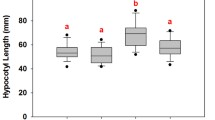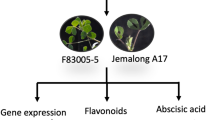Abstract
The leaves and photosynthetic stems of Cistus ladanifer, a plant that colonizes arid lands, secrete an exudate that shows a large seasonal variation in its flavonoid content. The maximum secretion of flavonoids in the exudate is produced during summer, increasing approximately three-to fourfold with respect to the secretion measured in spring. Summer is the season in which the plant suffers the greatest stress from environmental physical variables such as UV irradiation, high temperatures, and hydric stress. Studies were conducted in plants from several locations, which were selected considering daily UV irradiation (open or shaded areas), annual precipitation, and annual average maximum and minimum temperatures. Additional studies to control UV irradiation, drought, and temperature separately were performed with C. ladanifer plants growing in a glasshouse and in a culture room. The UV irradiation was found to be the major inducer of the enhanced flavonoid secretion during summer, because no significant increase of flavonoid secretion during summer was observed when the C. ladanifer plants in the field were covered with a Plexiglas box (total UV absorption below 380 nm). These results support an ecophysiological role of the flavonoids in the exudate to protect the plant against the damaging effects of UV irradiation. The culture room experiments confirmed this point and also showed that the induction of flavonoid secretion by UV irradiation is synergistically augmented by drought. The glasshouse and culture room experiments showed drought and high temperatures (between 30° and 45°C) to correlate with the summer increase of the more methylated flavonoids (kaempferols and 7-methylated apigenins) in the exudate. Because these more methylated flavonoids have higher hydropathy than the less methylated, these results suggest that the secretion of more methylated flavonoids is part of the defense mechanism of the plant against the hydric stress of summer.
Similar content being viewed by others
REFERENCES
ARIMOTO, Y., and HOMMA, Y. 1988. Studies on Citrus melanose and Citrus stem-end rot by Diaporthe citri (Faw) Wolf. Part 9. Effect of light and temperature on the self-defense reaction of Citrus plants. Ann. Phytopathol. Soc. Jpn 54:282–289.
BALAKUMAR, T., VICENT, H. B., and PALIWAL, K. 1993. On the interaction of UV-B radiation (280–315 nm) with water stress in crop plants. Physiol. Plant. 87:217–222.
BELL, E. A. 1980. The possible significance of secondary compounds in plants, pp. 11–21, in E. A. Bell and B. V. Charlwood (eds.). Secondary Plant Products. Springer-Verlag, New York.
BOHM, B. A., BANEK, H. M., and MAZE, J. R. 1984. Flavonoid variation in North American Menziesia (Ericaceae). Syst. Bot. 9(3):324–345.
CABEZAS, J., and ESCUDERO, J. C. 1989a. Caracterización de los gradientes térmicos estivales en pastos adhesados e intervención de Cistus crispus L. en su distorsión. Pastos (No Extra.):137–144.
CABEZAS, J., and ESCUDERO, J. C. 1989b. Estudio termométrico de la provincia de Badajoz. Dirección General de Investigación, Extensión y Capacitación Agraria, Badajoz.
CABEZAS, J., NUÑEZ, E., ESCUDERO, J. C., and MARROQUIN, A. 1983. Estudio pluviométrico de la provincia de Badajoz. Consejería de Agricultura y Comercio, Badajoz.
CASTILLO, J., BENAVENTE, O., and DEL RIO, J. A. 1992. Naringin and neohesperidin levels during development of leaves, flower buds and fruits of Citrus aurantium. Plant Physiol. 99:67–73.
CEN, Y. P., and BORNMAN, J. F. 1993. The effect of exposure to enhanced UV-B radiation on the penetration of monochromatic and polychromatic UV-B radiation in leaves of Brassica napus. Physiol. Plant. 87:249–255.
CHAPELL, J., and HAHLBROCK, K. 1984. Transcription of plant defence genes in response to UV light or fungal elicitor. Nature 311:76–78.
CHAVES, N. 1991. Estudio sobre la variación estacional de la composición del ládano en Cistus ladanifer L. Master's thesis. Facultad de Ciencias, Universidad de Extremadura, Badajoz Spain.
CHAVES, N. 1994. Variación cuantitativa de los flavonoides del flavonoides del exudado de Cistus ladanifer L. como respuesta a differentes factores ecológicos. PhD dissertation. Universidad de Extremadura, Badajoz, Spain.
CHAVES, N., ESCUDERO, J. C., and GUTIERREZ-MERINO, C. 1991. Caracterización por térmicos espectrolots metricos del ultravioleta y visible del exudado de Cistus ladanifer L. como respuesta al estrés estival. Studia Oecológica 3:57–68.
CHAVES, N., ESCUDERO, J. C., and GUTIERREZ-MERINO, C. 1993. Seasonal variation of exudate of Cistus ladanifer. J. Chem. Ecol. 19(11):2577–2591.
COOPER-DRIVER, G., FINCH, S., and SWAIN, T. 1977. Seasonal variation in secondary plant compounds in relation to the palatability of Pteridium aquilinum. Biochem. Syst. Ecol. 5:177–183.
CURIR, P., VANSUMERE, C. F., TERMINI, A., BARTHE, P., MARCHESINI, A., and DOLCI, M. 1990. Flavonoid accumulation is correlated with adventitious roots formation in Eucalyptus gunnii hook micropropagated through axillary bud stimulation. Plant Physiol. 92:1148–1153.
GOTTSTEIN, A., and GROSS, D. 1992. Phytoalexins of woody plants. Trees 6:55–68.
GOYAL, A. 1987. Effects of water stress on glycolate metabolism in the leaves of rice seedlings (Oryza sativa). Physiol. Plant. 69:289–294.
GRAHAM, L. T. 1991. Flavonoid and isoflavonoid distribution in developing soybean seedling tissues and in seed and root exudates. Plant Physiol. 95:594–603.
HARBORNE, J. B. 1967. Comparative Biochemistry of the Flavonoids. Academic Press, New York.
HARBORNE, J. B. 1977. Flavonoids and the evolution of the angiosperms. Biochem. Syst. Ecol. 5:7–22.
HARBORNE, J. B. 1988. Introduction to Ecological Biochemistry. Academic Press, London.
HARBORNE, J. B., MABRY, T. J., and MABRY, H. 1975. The Flavonoids. Chapman and Hall, London.
JALAL, M. A. F., READ, D. J., and HASLAM, E. 1982. Phenolic composition and its seasonal variation in Calluna vulgaris. Phytochemistry 21(6):1397–1401.
LAMAISON, J. L., and CARNART, A. 1991. Teneurs en pricipaux flavonoïdes des fleurs et des feuilles de Crataegus monogyna et de C. laevigata (Poiret) DC. en fonction de la période de végétation. Plant. Med. Phytol., 25(1):12–16.
LES, H. D., and SHERIDAN, D. J. 1990. Biochemical heterophylly and flavonoid evolution in North American Potamogeton (Potamogetonaceae). Am. J. Bot. 77(4):453–465.
LI, M. M., OU-LEE, T. M., RABA, R., AMUDSON, R. G., and LAST, R. L. 1993. Arabidopsis flavonoids mutants are hypersensitive to UV-B irradiation. Plant Cell 5:171–179.
MATÍAS, M. D. 1990. Análisis de la estructura espacio-temporal de comunidades vegetales en campos abandonados de los Arribes del Duero. PhD dissertation. Universidad de Salamanca, Salamanca.
MCCLURE, J. W. 1986. Physiology of flavonoids in plants, pp. 77–85, in V. Cody, E. Middleton, Jr., and J. B. Harborne (eds.). Plant Flavonoids in Biology and Medicine—Biochemical, Pharmacological, and Structure Activity Relationships. Alan R. Liss, New York.
MCDOUGAL, K. M., and PARKS, C. R. 1986. Environmental and genetic components of flavonoid variation in red oak. Quercus rubra. Biochem. Syst. Ecol. 14(3):291–298.
PACHECO, P., CRAWFORD, D. J., STUESSY, T. F., and SILVA, M. 1985. Flavonoid evolution in Robinsonia (Compositae) of the Juan Fernandez islands. Am. J. Bot. 72(7):989–998.
PANAGOPOULOS, I., BORNMAN, J. F., and BJORN, L. O. 1992. Response of sugar beet plants to ultraviolet-B (280–320 nm) radiation and Cercospora leaf spot disease. Physiol. Plant. 84:140–145.
SIEGELMAN, H. W. 1964. Physiological studies on phenolic compounds, pp. 437–456, in J. B. Harborne (ed.). Biochemistry of Phenolic Compounds. Academic Press, New York.
TAKAHAMA, U. 1988. Hydrogen peroxide-dependent oxidation of flavonoids and hydroxycinnamic acid derivatives in epidermal and guard cells of Tradescantia virginiana, L. Plant Cell. Physiol. 29(3):475–481.
TEVINI, M., and TERAMURA, A. H. 1989. UVB effects on terrestrial plants. Photochem. Photobiol. 50(4):479–487.
TEVINI, M., IWANZIK, W., and TERAMURA, A. H. 1983. Effects of UV-B radiation on plants during mild water stress. II Effects on growth, protein and flavonoid content. Z. Pflanzenphysiol. 110:459–467.
VOGT, T., and GÜLZ, P. G. 1991. Isocratic column liquid chromatographic separation of a complex mixture of epicuticular flavonoid aglycones and intracellelar flavonol glycosides from Cistus laurifolius L. J. Chromatogr. 537:453–459.
VOGT, T., PROKSCH, P., and GÜLZ, P. G. 1987. Epicuticular flavonoid aglycones in the genus Cistus, Cistaceae. J. Plant Physiol. 131:25–36.
VOGT, T., GÜLZ, P. G., and REZNIK, H. 1991. UV radiation dependent flavonoid accumulation of Cistus laurifolius L. Z. Naturforsch. 46c:37–42.
WEBB, M. E., and HARBORNE, J. B. 1991. Leaf flavonoid aglycone patterns and sectional classification in the genus Vicia (Leguminosae). Biochem. Syst. Ecol. 19(1):81–86.
WOODHEAD, S. 1981. Environmental and biotic factors affecting the phenolic content of different cultivars of Sorghum bicolor. J. Chem. Ecol. 7(6):1035–1047.
ZISKA, L. H., and TERAMURA, A. H. 1992. CO2 enhancement of growth and photosynthesis in rice (Oryza sativa). Modification by increased ultraviolet-B radiation. Plant Physiol. 99:473–481.
ZISKA, L. H., TERAMURA, A. H., SULLIVAN, J. H., and MCCOY, A. 1993. Influence of ultraviolet-B (UV-B) radiation on photosynthetic and growth characteristics in field-grown cassava (Manihot esculentum Crantz). Plant Cell Environ. 16:73–79.
Rights and permissions
About this article
Cite this article
Chaves, N., Escudero, J.C. & Gutierrez-Merino, C. Role of Ecological Variables in the Seasonal Variation of Flavonoid Content of Cistus ladanifer Exudate. J Chem Ecol 23, 579–603 (1997). https://doi.org/10.1023/B:JOEC.0000006398.79306.09
Issue Date:
DOI: https://doi.org/10.1023/B:JOEC.0000006398.79306.09




